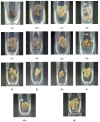Induction, Multiplication, and Evaluation of Antioxidant Activity of Polyalthia bullata Callus, a Woody Medicinal Plant
- PMID: 33327608
- PMCID: PMC7765093
- DOI: 10.3390/plants9121772
Induction, Multiplication, and Evaluation of Antioxidant Activity of Polyalthia bullata Callus, a Woody Medicinal Plant
Abstract
Polyalthia bullata is an endangered medicinal plant species. Hence, establishment of P. bullata callus culture is hoped to assist in mass production of secondary metabolites. Leaf and midrib were explants for callus induction. Both of them were cultured on Murashige and Skoog (MS) and Woody Plant Medium (WPM) containing different types and concentrations of auxins (2,4-dichlorophenoxyacetic acid (2,4-D), α-naphthaleneacetic acid (NAA), picloram, and dicamba). The callus produced was further multiplied on MS and WPM supplemented with different concentrations of 2,4-D, NAA, picloram, dicamba, indole-3-acetic acid (IAA), and indole-3-butyric acid (IBA) media. The quantification of total phenolic content (TPC), total flavonoid content (TFC) and antioxidant capacity was further carried out on P. bullata callus, and the results were subjected to correlation analysis. Among the media, the WPM + 16.56 µM picloram (53.33 ± 22.06%) was the best for callus induction while MS + 30 µM dicamba was the best for callus multiplication. The TPC, TFC, and EC50 of DPPH scavenging activity were determined at 0.657 ± 0.07 mg GAE/g FW, 0.491 ± 0.03 mg QE/g, and 85.59 ± 6.09 µg/mL in P. bullata callus, respectively. The positive correlation between DPPH scavenging activity with TPC was determined at r = 0.869, and that of TFC was at r = 0.904. Hence, the P. bullata callus has an ability to accumulate antioxidants. It therefore can be a medium for secondary metabolites production.
Keywords: Polyalthia bullata; antioxidant activity; auxins; callus induction; callus multiplication; total flavonoid content; total phenolic content.
Conflict of interest statement
The authors declare no conflict of interest.
Figures







References
-
- Global Information Hub on Integrated Medicine. [(accessed on 30 August 2019)]; Available online: http://www.globinmed.com/
-
- Connolly J.D., Haque M.E., Kadir A.A. Two 7, 7′-bisdehydroaporphine alkaloids from Polyalthia bullata. Phytochemistry. 1996;43:295–297. doi: 10.1016/0031-9422(96)00219-1. - DOI
-
- Paarakh P.M., Khosa R.L. Phytoconstituents from the genus Polyalthia—A review. J. Pharm. Res. 2009;2:594–605.
-
- Nantapap S., Punyanitya S., Nuntasaen N., Pompimon W., Meepowpan P. Flavones from aerial parts of Polyalthia bullata and cytotoxicity against cancer cell lines. Chem. Nat. Compd. 2017;53:762–763. doi: 10.1007/s10600-017-2114-0. - DOI
Grants and funding
LinkOut - more resources
Full Text Sources

